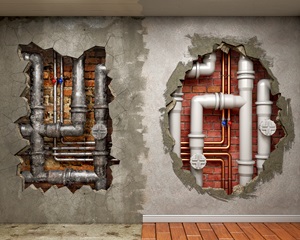When it comes to plumbing, one size doesn’t fit all. The type of plumbing pipes used in your home can significantly impact its durability, maintenance, and water quality. Whether you own an older home with original plumbing or a modern construction, understanding the key differences and considerations is essential for maintaining a healthy plumbing system. Let’s explore the world of plumbing pipes in old homes versus modern constructions.
Plumbing Pipes in Old Homes
- Galvanized Steel Pipes
- Lead Pipes
- Cast Iron Pipes
Older homes often feature galvanized steel pipes, which were popular in the past. While durable, these pipes are prone to rust and corrosion over time, reducing water flow and potential contamination.
In some very old homes, lead pipes may still be in use. Lead poses a severe health risk and should be replaced immediately to ensure safe drinking water.
Cast iron pipes were once a staple for drainage systems. While they’re robust and durable, they can corrode and become brittle over time, leading to leaks and blockages.
Modern Constructions
- Copper Pipes
- PEX (Cross-Linked Polyethylene) Pipes
- PVC (Polyvinyl Chloride) Pipes:
Copper is a popular choice in modern plumbing due to its durability and resistance to corrosion. It provides clean, safe drinking water and has a long lifespan.
PEX pipes are flexible, easy to install, and resistant to freezing. They are a common choice for water supply lines in modern homes.
PVC pipes are commonly used for drainage and wastewater systems. They are lightweight, durable, and resistant to chemical corrosion.
Key Considerations
1. Water Quality
The type of pipes in your home can impact water quality. Older homes with lead or corroded pipes may require water filtration or pipe replacement to ensure safe drinking water.
2. Maintenance
Older homes with outdated plumbing systems often require more frequent maintenance and repairs. On the other hand, modern plumbing systems are designed for longevity and lower maintenance.
3. Replacement Costs
Upgrading plumbing in an older home can be costly, but it’s often necessary for safety and functionality. In contrast, modern plumbing systems are more cost-effective in the long run.
4. Environmental Impact
Modern plumbing materials are often more eco-friendly and contribute to water conservation efforts.
Choosing the Right Pipes
Whether you live in an older home or a modern construction, understanding your plumbing system’s pipes is crucial. It affects your home’s water quality, maintenance needs, and long-term costs. If you’re unsure about the state of your plumbing pipes or considering an upgrade, consult with a professional plumber for guidance and ensure your home’s plumbing remains reliable and safe.
At Top Tier Plumbing and Rooter, we specialize in plumbing assessments, upgrades, and maintenance for homes of all ages. Contact us today by calling (951) 475-6521for expert advice and services.


